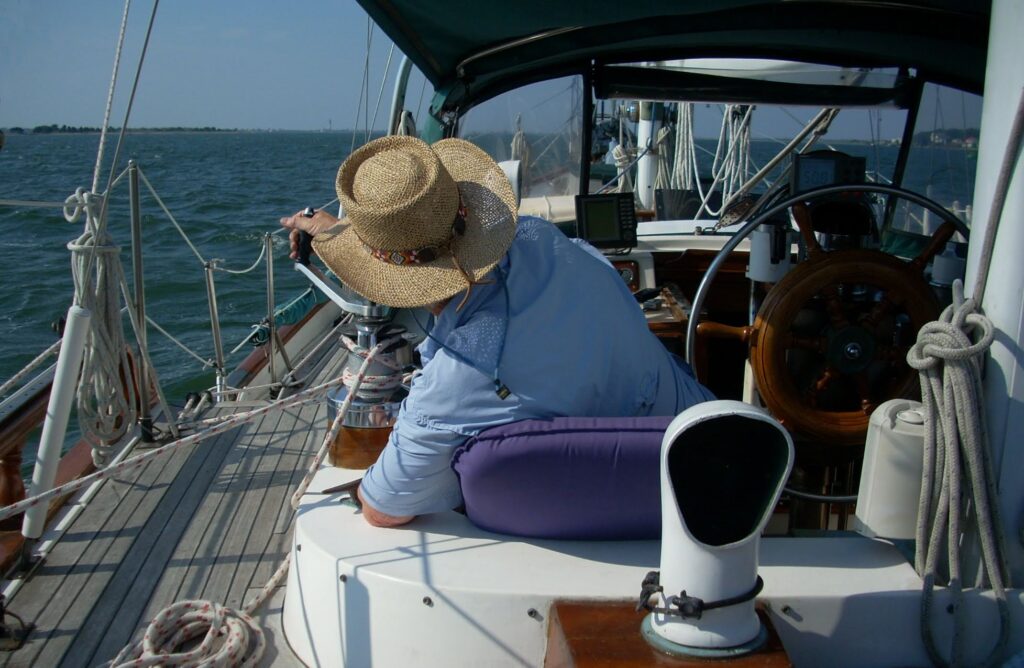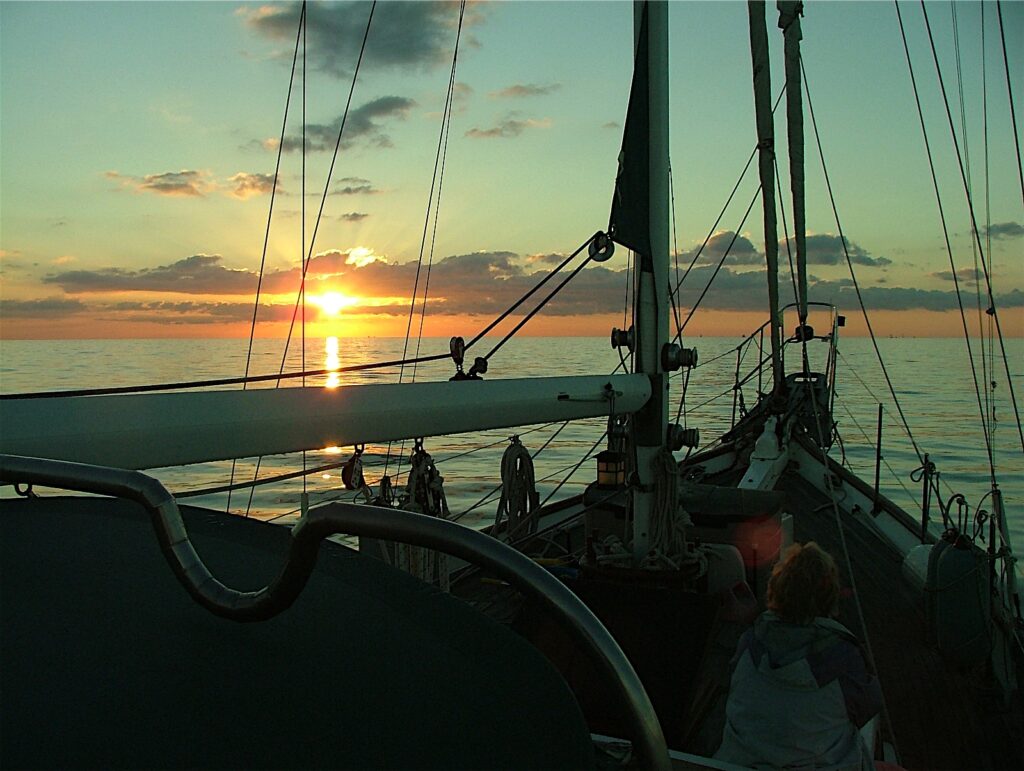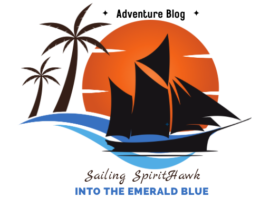My Father, Don Hanson, taught me to sail. This one of my favorite boats of his pictured here. He started sailing when I was Less than 10 years old. we had always been a boating family. My two brothers and I have been on boats since we were babies. The following is an article I wrote about 31 things I learned about sailing during a boating trip with him. The year was 2006 and he and I were on a 3 week sailing journey with him. We were moving the boat between The Chesapeake Bay and Miami.
I have been boating since I was about three and I have been sail boating since I was twelve. This trip has been like the old adage, “you learn something new everyday.” Or one of my mottos: you should learn something new everyday. I started making a list of what I have learned about how to do things while living aboard the sailing yacht, Majestic Dream. It also includes some of my observations about how stuff works on the water, in the water and on the boat. I came up with thirty-one things, I am sure there were more. That is why I took lots of photographs on this trip….

Shrimp snap, yes there are snapping shrimp. At first we thought they were just tiny shrimp that swam around eating from the bottom of the boat at night. The noise was very loud and it sounded like there were thousands of them. And, you can hide a submarine from enemy radar with the help of these snapping shrimp! I looked it up on the Internet. The shrimp are a special kind that come out of the mud at night to eat. This part is true. The snapping noise is because they have one large claw that catches a bubble of air in it and when they open the claw to grab their food the bubble pops, and there you have it snapping shrimp.
There are things on a boat that I never knew you had to clean like lifelines. For the land lubbers, life lines are wire cables coated with heavy white plastic, sort of like thick clothesline. Tannic water, sunscreen, sweat and other dirt discolor them. A scotchbrite pad and some simple green combined with a lot of scrubbing makes them bright and white again.
It’s more fun to clean the bathroom (head) on a boat because you never know what you might see outside the portal (window). Today I saw a Navy Destroyer on the horizon. How often does that happen at home? My Father, the Captain of the sailing vessel we are on, informed me that only “you and John Stuart would care about something like that.“ I am not sure I know who John Stuart is but I have been told he is on night time TV. I plan to look him up on the Internet next. But back to cleaning, when there are no entertaining sea gulls, pelicans, ducks or destroyer ships to look at, the water itself is ever changing. Some days it smooth as glass, others four to five foot waves rolling by and on others days the wash of the water running past the sides of the boat can be quite relaxing. I also learned that when the boat is heeling, tipping way up on one side, it is easier to work on the low side. As far as the actually scrubbing goes it’s easy to rinse since the head is sometimes the shower on a boat, so the showerhead sprayer can reach everywhere and there is always a drain!
Adults over seventy seem to find great enjoyment in asking “Are we there yet?” This from the same man who, when I was child, would have been upset with me for asking, again. I thought it was funny too but for different reasons. The average day of sailing covers about seventy miles. This leads to periodic choruses of, “Are we there yet?”.
You need five feet of anchor chain for every one foot of depth to the bottom. I also learned how to set the anchor by feeding out the first fifty feet and then letting the weight of the boat tug on it before feeding out the rest.
A gypsy is the machinery that winds and unwinds the anchor chain.
Snubbers are the two lines, one to port (left side of boat) and one to starboard (right side of boat) that tie from the front chocks (sort of a handle with two points that you wrap a line around in figure eight fashion) and connect to the anchor chain with a special metal type of hook that slips over a chain link and then locks into it. The tension of the anchor will then pull on those two lines evenly instead of on the bow of the boat, with less wear and tear on the gypsy and the bow sprit.
Canned chicken can replace sausage or meatballs, in the spaghetti, when you run out of fresh meat.
Not all markers and buoys have lights on the them.
Even a fake pirate ship can be a little intimidating on a dark moonless night.
The dolphins you see in the coves, rivers and sounds of the Intercoastal Waterway do not play on top of the water as much as the ones you see at Sea World.
A telephoto lens on a camera might look like something else to a Navy gun boat patrolling their ships. It’s not advisable to point it at them.
All dial up internet is not the same. You can use certain cell phones as a modem and connect to the Internet at approximately 115,000 bps. That is twice as fast as regular dial up at home. What’s up with that? I will be researching that as well
You can catch catfish with crabs.
Seagulls will catch fish that are too heavy for them to pick up.
There is a VERY LOUD boom when the bumpers slip out between the pilings and the boat when you are at a marina at night.
The security announcement by the U. S. Coast guard are announced by repeating “Securitay, Securitay” with a long “A” instead of an long “E” as if we were in France. This one I did look up and Securite is an International Marine word. According to Wikipedia, http://en.wikipedia.org/wiki/Securite , “When a marine radio transmission begins with “Sécurité, sécurité, sécurité” pronounced ‘Say-cur-i-tay’, after the French word), it means that which follows is important safety information. The most common use of this is by coast radio stations before the broadcast of navigational warnings and meteorological information.It is normal practice to broadcast the Sécurité call itself on a distress and listening frequency such as VHF Channel 16 or MF 2182 kHz, and then change frequency to a working channel for the body of the messages.”
If you engine fails at a draw bridge you have to call the Bridge and advise them you will be coming through under sail. This is normally not allowed. If the nearest marina is still seventy miles a way you better have enough crew on board to help maneuver the boat. A sailboat can only sail at certain angles to the wind, called tacking, and the waterway is only ninety feet wide, not always all of it deep enough to use. You will be taking a lot. Hundreds of times. Though exhausting this is much cheaper than calling Sea Tow!
Not everyone traveling by boat knows how to handle their boat.

Some power boaters are like the car that tail gates you only to make a turn in front of you. On the waterway some of them pass you fast, creating lots of wake to rock your boat, and then they will be sitting at idle at the next draw bridge which may not be opening for another half of an hour. We all wait together.
Traveling up the ICW (Intercoastal Waterway) every spring and down it to return to Florida every fall takes about two weeks by sail boat without much site seeing in the ports along the way. A vessel can trim two or three days off the trip by going out into the Ocean, weather, meaning wind and waves, permitting. There are lots of sites to see all along the ICW however. Small towns, large cities, fishing villages, Naval Bases, and for architecture you have multi-million dollar homes or palaces, ranch homes, New England style homes, New Mexico style homes, some on stilts some not, boat houses, docks of every style, with gazebos , decks with roofs and with out.
Most boaters, like most motorcyclists, wave as they pass each other. On a boat, if they do not wave they are usually mad at how you passed them.
The auto pilot is a wonderful invention. When you are on a long trip everyone can have lunch together and the boat can steer itself. When It’s really cold out you can sit to the side instead of behind the wheel and adjust your course by pushing buttons on the control panel, you never have to touch the wheel or sit out in the rain. If you are right in the middle of a good book you can let the boat steer and just look up every few minutes to check on what lays out before you, keep in mind this is only advisable when you are sailing out where there are few boats and you can see them coming from far off.
After about a week and a half on a boat an exercise plan becomes more important. You can start to feel pretty lazy when you cannot get ashore for a nightly walk and it’s too cold or muddy to swim. I guess you could walk around and around the boat or use your body for weight lifting off the seats.
When the Navy is doing “live” testing in one of their, not always restricted, target areas it is important to be monitoring you radio. They will be calling any vessel that is heading into their hazard pattern. Any encroachment within five hundred yards of their markers will may be considered a breach of security.
Pelicans dive bomb like a kamikaze pilot to catch tack heir dinner. They just crash right into the water. Sometimes they get a fish, sometimes they don’t, but they keep on trying, time after time. We could learn from their tenacity.
We saw some boats that were still “up on the hard” after the last hurricaine. Up on the hard can refer to the land, the shore, the boat yard, the parking lot, anything not in the water. Does that mean that, instead of being land lubbers, people who do not pursue boating are hardlanders?
On the other hand, people who make their living on the water are called “Watermen”.
Where does that leave those who make their living on the land?
Sailboats sporting a black sail have their sails made from some kind of carbon fiber. The heavy duty sails that I was familiar with, until now were made of Kevlar much like some firefighting and police equipment.
Sea Legs. I have not had to truly develop sea legs in many years. Brief sails on calm waters do not require much in the way of sea legs. Heading below decks takes on a different tack when you are traveling ten to fifteen hours a day and still need to make lunch, use the head and other normal daily activities. Walking on a boat in rough water is hard to explain. Sea legs refers to the ability to walk on a boat even in rough water when the boat is rocking, bouncing and sometimes heeled well over to one side. Walking when the boat is tipping back and forth and up and down takes planning. I had forgotten what it was like. It’s as if you need to know when to take whole steps and half step. I am not referring to the length of your stride so much as I am how high you pick up your legs and when you place them back down. Walking in that kind of sea is a lot like a dance. Sometimes you have to lean forward as if you were walking up hill to plan for the next foot placement properly, if you do not you do not have enough forward motion to complete the step. This leads to landing to hard or falling backwards. Ether of these can lead hitting your head. The walls and ceilings are not where they were when you were on flat ground. It also becomes very clear why all of the cupboard doors have exterior latches. This is not childproofing, as it might appear, this is so everything does not fall out onto the floor in total chaos. Getting hit with a can of beans on bare toes is not pleasant; neither is getting hit in the head with the sharp corner of the cupboard. One door left unlatched will remind you of this in a hurry.
A Ham operating station referred to as St. Jude keeps track of all the boats on the Eastern United States Waterways and out to the Bahamas. I think that their efforts, on a daily basis, are very selfless and an amazing contribution to the welfare of all the boating folks. There are specific times for each area to call and check in everyday, advising St. Jude of their boat name and location. Some days boats that could not talk to each other, due to distance, had messages relayed through St. Jude

